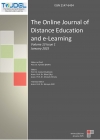TOJDEL - Volume 3 - Issue 3 - July 2015
 AGRICULTURAL EDUCATION IN BANGLADESH OPEN UNIVERSITY
AGRICULTURAL EDUCATION IN BANGLADESH OPEN UNIVERSITY Md. Farid Hossain
Abstract: This paper discusses the status of agricultural education in Bangladesh Open University. The need for transfer of updated agricultural technology is at the top of the agricultural policy of the country. Research institutes are usually generates Technology; it is transferred through different extension approaches and mass media to the learners and farmers. The Bangladesh Open University (BOU) is to expand all levels of education in different fields. The School of Agriculture and Rural Development (SARD) of BOU is to impart education through distance mode comprising formal and non-formal programs in the field of agriculture and rural development. The learning procedure also includes tutorial supported audio and video programs. The School of Agriculture and Rural Development is offering four formal programmes namely, Bachelor of Agricultural Education (B.Ag.Ed), Diploma in Youth in Development Work (DYDW), Certificate in Livestock and Poultry (CLP) and Certificate in Pisciculture and Fish Processing (CPFP). Learners├óŌé¼Ōäó participation in the tutorial classes at tutorial centres (TCs) of SARD programmes is not satisfactory and missing practical sessions seriously hampers the learners. To improve the overall situation for ensuring quality of the SARD programmes that includes imposition of compulsion on the students to attend the practical sessions, emphasize on research facilities of faculty members, updating the study materials, timely distribution of learning materials, broadcast of media programmes and result publication.
 Brick and Mortar University on the Way to Virtual University
Brick and Mortar University on the Way to Virtual University Prof. Bednarczyk Malgorzata
Abstract: Nowadays existence of every university is based on internet. In educational settings it is used for storing results and students' data, communication inside an organization, between an organization and students, teachers and students, between peers. Even brick and mortar universities are indeed semi- virtual organizations. It is no longer a question of using internet or not, it is a question of what it is used for. It is a profound dilemma especially for universities that have a reputation and long tradition of higher education. Internet lowers the costs of educational practices but how to preserve high outcomes of learning? What are the barriers that are needed to be overcome? How does it effect the academic level of students, faculty members and the institution by itself? Could all of the fields of study be offered as an online course? Presented is a sample of Art Education.
 Cultural Competence And Intercultural Communication In The Didactics Of Foreign Languages
Cultural Competence And Intercultural Communication In The Didactics Of Foreign Languages Magdalena Lewicka
Abstract: For many years European glottodidactics has been postulating for joining the practice of foreign language teaching with the presentation of the realities and culture which resulted in birth of a new glottodidactic sub-discipline called intercultural glottopedagogics, also known by the following terms: die Landeskunde (German), area studies (English), la civilisation (French), la civilt.. (Italian) or stranovedenie (Russian). There is a growing conviction that foreign language teaching should be deeply embedded in the cultural context, including introduction of the culture of a given language area and information about intercultural differences, since despite the fact that in currently dominating communicative approach the key didactic objective is the ability of efficient communication, the indisputable fact is the threat of the efficiency of the communication in the given language posed by the lack of so called intercultural competence. It is defined as the ability to communicate with the members of different cultural circles and nations and the ability to build the ├óŌé¼┼Šbridges of agreement├óŌé¼┬Ø, in other words ├óŌé¼ŌĆ£ complex ability to manage oneself in the complicated reality of multilingual and multi-cultural contemporary world. The objective of my paper is the reflection upon cultural problems on the ground of foreign languages, current issues of intercultural approach in the didactics of foreign languages, place and role of intercultural competence among the goals of language teaching, as well as mutual relationship between cultural and communicative competence, theoretical premises and concepts underlying the basis of practical solutions of intercultural teaching and emphasising the function of glottodidactics consisting in approaching the culture of the target language country and explaining intercultural differences, hence the outline of the problems of intercultural tendencies on the ground of contemporary glottodidactics.
 E-Learning Readiness in Medicine: Turkish Family Medicine (FM) Physicians Case
E-Learning Readiness in Medicine: Turkish Family Medicine (FM) Physicians Case Alaattin Parlakk├ä┬▒l├ä┬▒├ā┬¦
Abstract: This research investigates e-learning readiness of family medicine physicians in Turkey. The study measures the level of e-learning readiness of Turkish FM physicians. A cross-sectional survey was delivered online. Overall, to implement successful e-learning framework family medicine physicians in Turkey the results show that overall five areas are ready at Turkish FM but need a few improvements: equipment/infrastructure, Online learning style readiness, technological skills readiness, cultural readiness, financial readiness. Three areas are not ready and need some work to improve their readiness: Human resource readiness, attitude readiness, and environmental readiness. According to outcomes of e-learning readiness survey Turkish Family Medicine Physicians├óŌé¼Ōäó e-learning readiness indicate that the physicians are for adopting e-learning . The results show that the level readiness at Turkish FM was ready at 68,28 %, and ready but needs a few improvements for readiness.
 Freeware and Open Source Software Tools for Distance Learning in Mathematics
Freeware and Open Source Software Tools for Distance Learning in Mathematics Farha Sattar, Laurence Tamatea, Muhammad Nawaz
Abstract: With the contemporary growth of modern technology a number of free and open source software tools have been emerged to support online or distance education for basic level Mathematics. Technological aids for example; digital learning material, videos, recorded lectures, open tools to solve mathematical problems, online discussion boards, and online classrooms enhance the ability of students to solve mathematical problems. This research paper enlists the freeware and open source software tools for teaching and learning in mathematics and describes the role of technology for improved delivery of mathematical concepts. It also shows that how freeware and open source software tools are useful for distance education to achieve learning outcomes in a better flexibility and dynamism than ever before.
 Motivation and Retention: A Comparison between Fully Online Students and On-Campus Students Taking Online Courses
Motivation and Retention: A Comparison between Fully Online Students and On-Campus Students Taking Online Courses Ernesto Gonzalez
Abstract: The objective of this study is to assess the impact of intrinsic motivation, extrinsic motivation, and amotivation on retention for online students and on-campus students taking online courses at Florida National University. The descriptive analysis, which was based on the selfdetermination theory, used the Academic Motivation Scale adapted to online setting. The results show high values of intrinsic and extrinsic motivation for the two groups of students, but no statistical significant differences. However, the values of amotivation and the intention to continue taking online courses (retention) were statistically different. Structural equation modeling revealed that intrinsic and extrinsic motivation had a positive impact on retention for both groups. On the other hand, amotivation had a significant negative influence.
 Students learning style and attitude with information visualization
Students learning style and attitude with information visualization Dalia Alyahya, Suzan Alyahya
Abstract: This study focuses on how learners process information visualization by exploring the relationship between fifty undergraduate learners├óŌé¼Ōäó performance and their viewing behaviors gained from eye tracking. Furthermore, students├óŌé¼Ōäó learning styles was investigated through different deployed learner attention. Learner preferences towards the usage of information visualization content for learning was discussed through qualitative and quantitative results. These results explored the in-depth understanding of learner behavior while learning from visual content such as areas of interest, time spent on object, visual paths and frequency of visits to an object.
 The Impact Of Synchronous And Asynchronous Communication Tools On Learner Self-Regulation, Social Presence, Immediacy, Intimacy And Satisfaction In Collaborative Online Learning
The Impact Of Synchronous And Asynchronous Communication Tools On Learner Self-Regulation, Social Presence, Immediacy, Intimacy And Satisfaction In Collaborative Online Learning Mahnaz Moallem
Abstract: The emergence of the newer web synchronous conferencing has provided the opportunity for a high level of students to students and students to instructor interaction in online learning environments. However, it is not clear whether absence or presence of synchronous or live interaction will affect the learning processes and learning outcomes to the same extent for all learners with various characteristics, or whether other factors that compensate for the absence of the live interaction can be identified. This paper reports the results of a case study that investigated whether various communication methods (synchronous, asynchronous and combined) impact factors such as self-regulation, social presence, immediacy and intimacy, collaboration and interaction and learning process and outcomes. Multiple sources of data were used to test the consistency of the findings and to examine various factors across different communication methods. The results suggest that factors other than communication methods maybe responsible for learner self-regulation. There is, however, a relationship between student satisfaction, perception of social presence and immediacy and communication methods. The synchronous and combination methods appeared to provide the highest level of social presence followed by the cognitive and emotional support.
 Three Learning Potentials In Digital Games: Perception Of Malaysian University Teachers
Three Learning Potentials In Digital Games: Perception Of Malaysian University Teachers Enas Noraddin
Abstract: This study aimed to investigate university teachers├óŌé¼Ōäó perceptions of the potential benefits, or the lack of them, in digital games for learning and teaching in higher education institutions in Malaysia. The survey was conducted by emailing the questionnaire, to which 273 teachers responded online. The study sought to find answers to a fundamental question: How do university teachers in Malaysia view digital games as motivational, collaborative and instructional tools? Moreover, it looked into how do university teachers differ in their views about digital games by such variables as age, gender, academic discipline and other independent variables. The study undertook a descriptive analysis along with t-test and ANOVA to examine possible relationships between teachers├óŌé¼Ōäó attitudes and their demographic information. The results showed a consistent pattern throughout where the majority of surveyed university teachers exhibited a favorable perception of the usage of digital games in higher education. It is noteworthy that the only variable that influenced such perception was the respondents' previous experience (or lack of it) in using digital game. The t-test and ANOVA results showed no relationships between respondents' demographic characteristics such as gender and age and favorable or unfavorable attitudes towards digital game usage in learning and teaching. Even though the majority of responding teachers had favorable attitude towards using digital games in their teaching , in practice fewer of them had used them for that purpose.
 Virtual Collaboration: A Phenomenological Study Of Remote Online Adjuncts Virtual Collaboration Lived Experiences
Virtual Collaboration: A Phenomenological Study Of Remote Online Adjuncts Virtual Collaboration Lived Experiences Dr. Lori Schieffer
Abstract: Online education is rapidly growing in higher education. This has left colleges needing to hire more part-time remote adjuncts to fill the fluctuating number of available courses. Because remote online adjuncts are susceptible to isolation, the need has arisen to study the benefits and barriers of virtual collaboration. The purpose of this phenomenological qualitative study was to examine the virtual collaboration lived experiences of remote online adjuncts. The study helped unveil the motives and lived experiences of virtual collaboration among online adjuncts. The composite description revealed nine themes about how participants experience virtual collaboration. The study suggests that higher education leaders would be well served to focus their efforts on leadership that will promote virtual collaboration practices. It is advisable that higher education leaders look for ways to provide leadership to connect collaborators, create opportunities for collaboration, and define clear roles for virtual collaboration. Remote online adjuncts may find camaraderie, social connections, an opportunity to participate in scholarship, a chance for self-reflection, and develop a sense of pride through virtual collaboration. Barriers that must be overcome for virtual collaboration included trust, a lack of time, and a feeling of pressure to participate.


